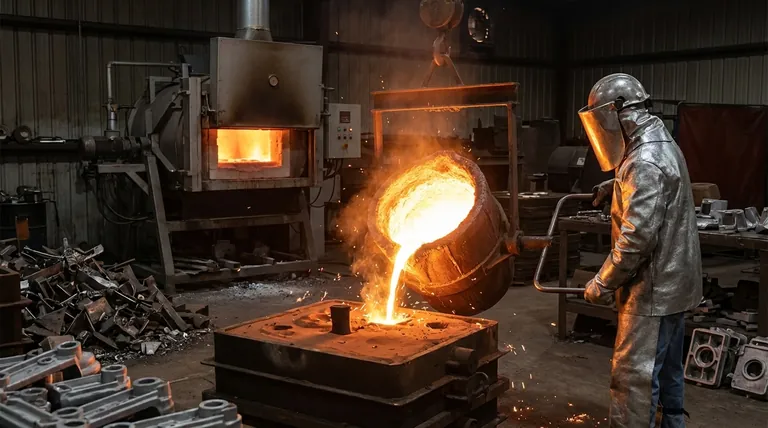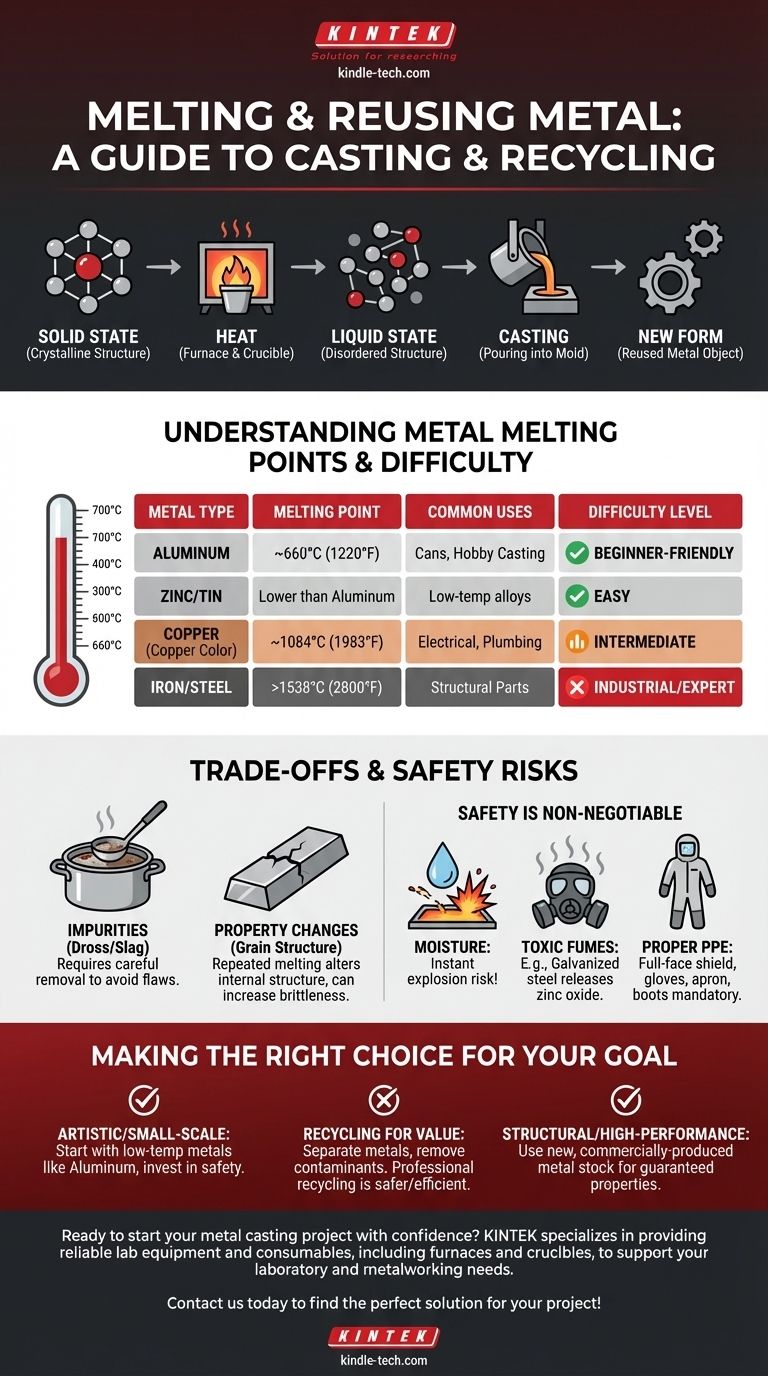Yes, you can absolutely melt metal to reuse it. This process, known as casting or smelting, is the fundamental principle behind all metal recycling and has been a cornerstone of human technology for thousands of years. It allows you to take scrap or existing metal objects, return them to a liquid state, and give them a new form.
The ability to melt and reuse metal is not a simple yes-or-no question. The real challenge lies in understanding the specific metal's properties, managing the inevitable impurities, and implementing strict safety protocols to achieve a successful outcome.

The Fundamental Process: From Solid to Liquid
Melting metal is a straightforward concept, but executing it correctly requires understanding the underlying science and having the right tools.
What Happens When Metal Melts?
Metals have a crystalline structure in their solid state. When you apply enough heat, the energy breaks the bonds holding this structure together, causing the metal to transition into a disordered, liquid state.
The Essential Tools: Furnace and Crucible
At a minimum, you need two key pieces of equipment. A furnace or forge provides the intense heat necessary to reach the metal's melting point, while a crucible—a container made from a material like ceramic or graphite with a much higher melting point—holds the liquid metal.
Casting: Giving Metal New Form
Melting is only the first step. To reuse the metal, you must pour it into a mold, a process called casting. The mold, often made of sand or steel, defines the final shape of the object as the metal cools and solidifies.
Why Not All Metals Are Created Equal
The feasibility of melting and reusing metal heavily depends on the specific type you are working with. The primary factor is the metal's melting point.
Accessible Metals: The Hobbyist's Choice
Metals with lower melting points are far more accessible for small-scale or home foundry work.
- Aluminum: Melts around 660°C (1220°F). It is lightweight, abundant (e.g., beverage cans), and one of the most common metals for hobbyist casting.
- Zinc and Tin: Melt at even lower temperatures, making them very easy to work with, though they are less common for general-purpose objects.
Industrial Metals: The High-Temperature Challenge
Other common metals require temperatures that are difficult and dangerous to achieve outside of an industrial setting.
- Copper: Melts at 1084°C (1983°F). It requires a more robust and powerful furnace.
- Iron and Steel: Melt at temperatures exceeding 1538°C (2800°F). Handling these requires specialized industrial furnaces, advanced safety equipment, and deep expertise.
The Complication of Alloys
Most metals we encounter are alloys—a mixture of a base metal with other elements. When you re-melt an alloy like brass (copper and zinc), some elements (like zinc) can burn off, altering the metal's final composition and properties.
Understanding the Trade-offs and Risks
Successfully reusing metal involves more than just heat. You must manage the downsides and be acutely aware of the dangers.
The Problem of Impurities
When you melt scrap metal, any paint, coatings, or oxidation on the surface will not simply disappear. These materials form a layer of impurities called dross or slag on top of the molten metal, which must be carefully skimmed off before pouring to avoid a weak or flawed final product.
Changes in Material Properties
Repeatedly melting and re-casting metal without proper technique can alter its internal grain structure. This can sometimes make the metal more brittle or change its mechanical properties, a critical consideration for any functional parts.
Safety is Non-Negotiable
Working with molten metal is extremely dangerous.
- Moisture: Even a tiny drop of water coming into contact with molten metal will instantly flash into steam, causing a violent explosion that can throw liquid metal everywhere. All tools, molds, and metal scraps must be perfectly dry.
- Toxic Fumes: Melting certain metals releases toxic fumes. For example, melting galvanized steel releases zinc oxide fumes, which can cause serious respiratory illness.
- Personal Protective Equipment (PPE): Proper PPE, including a full-face shield, leather gloves, apron, and boots, is absolutely mandatory to protect from catastrophic burns.
Making the Right Choice for Your Goal
Your approach to melting and reusing metal should be dictated by your end goal and your tolerance for risk.
- If your primary focus is artistic creation or small-scale casting: Start with a known, low-temperature metal like aluminum and invest heavily in proper safety equipment and a well-ventilated workspace.
- If your primary focus is recycling for value: Recognize that separating metals by type and removing contaminants is the most critical step. For most materials, using a professional recycling service is far safer and more efficient.
- If your primary focus is creating structural or high-performance parts: Always use new, commercially-produced metal stock. Its composition and properties are guaranteed, something nearly impossible to achieve in a hobbyist foundry.
Approaching this craft with knowledge and a deep respect for safety is the key to transforming discarded metal into something new and useful.
Summary Table:
| Metal Type | Melting Point | Common Uses | Difficulty Level |
|---|---|---|---|
| Aluminum | ~660°C (1220°F) | Cans, hobby casting | Beginner-friendly |
| Zinc/Tin | Lower than Aluminum | Low-temp alloys | Easy |
| Copper | ~1084°C (1983°F) | Electrical, plumbing | Intermediate |
| Iron/Steel | >1538°C (2800°F) | Structural parts | Industrial/Expert |
Ready to start your metal casting project with confidence? KINTEK specializes in providing reliable lab equipment and consumables, including furnaces and crucibles, to support your laboratory and metalworking needs. Whether you're recycling metals or conducting precise thermal experiments, our products ensure safety and efficiency. Contact us today to find the perfect solution for your project!
Visual Guide

Related Products
- Rotary Tube Furnace Split Multi Heating Zone Rotating Tube Furnace
- Vacuum Sealed Continuous Working Rotary Tube Furnace Rotating Tube Furnace
- Laboratory Vacuum Tilt Rotary Tube Furnace Rotating Tube Furnace
- 1400℃ Laboratory Quartz Tube Furnace with Alumina Tube Tubular Furnace
- Vertical Laboratory Quartz Tube Furnace Tubular Furnace
People Also Ask
- At what temperature does wood pyrolysis begin? Control the Process for Biochar, Bio-Oil, or Syngas
- What is a rotary retort furnace? Achieve Superior Uniformity in Continuous Heat Treatment
- How are tube furnaces classified based on the orientation of the tube? Choose the Right Design for Your Process
- What are the disadvantages of rotary kiln incinerator? High Costs and Operational Complexities
- What are the typical heating zone configurations and maximum temperature capabilities of tube furnaces? Find the Right Setup for Your Lab



















